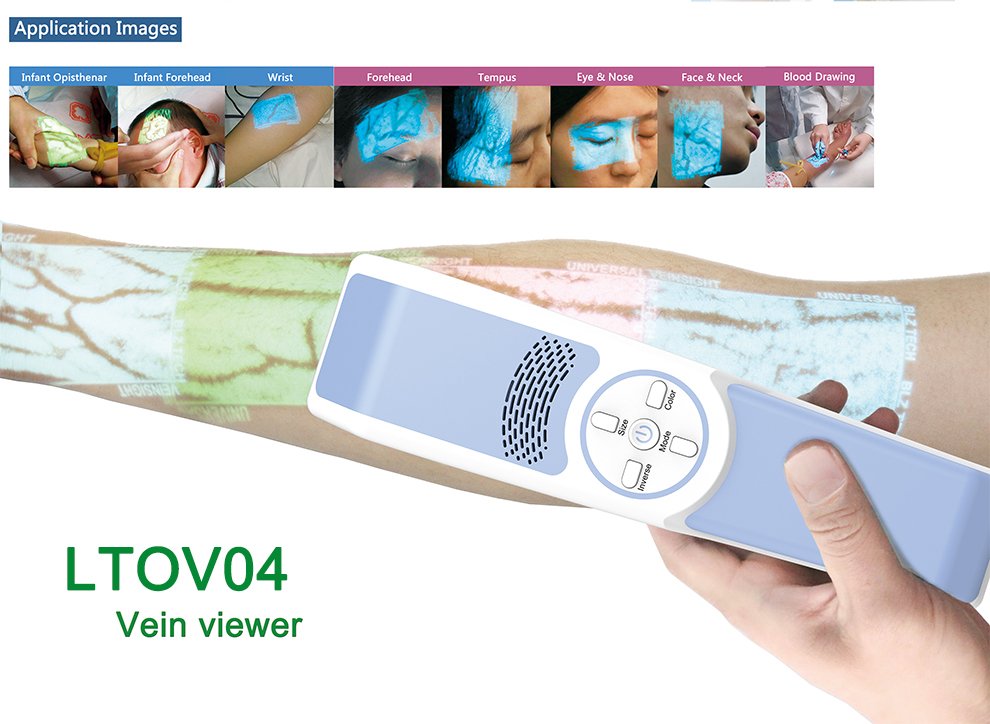How it does work? & FAQ -- LTOV04 vein viewer Shining the Light on Veins
Near-Infrared (NIR) Technology

Vein visualization and near-infrared technology
The basic principle is the use of intravenous red blood cells to absorb the characteristics of specific near infrared.The key is that hemoglobin in the erythrocytes flowing through the veins has an absorption effect on near-infrared rays with a wavelength of 700-1000 nanometers, resulting in less transmission of near infrared rays in the vein.
LTOV04 vein viewer uses harmless near-infrared (NIR) light, similar to the wave length of pulse oximetry. NIR light is projected onto the surface of the skin; hemoglobin absorbs the NIR and surrounding tissue disperses it. Projected near-infrared light is absorbed by blood and reflected by surrounding tissue.The information is captured, processed and projected digitally in real-time directly onto the surface of the skin. It provides a real-time accurate image of the patient's blood pattern.The depth of penetration of LTVF300 vein viewer is up to 10 mm deep for peripheral veins and up to 12 mm deep for blood patterns, blood within and without of the vein. Depth of visualization is dependent on the anatomy and condition of each patient.
With LTOV04 vein viewer clinicians can see peripheral veins, bifurcations and valves and assess in real-time the refill/flushing of veins. Through visualization pretreatment, intraoperative and postoperative, clinicians can avoid complications caused by accidental puncture. Improve the total vascular access procedure.
LTVF300 vein viewer can also provide valuable information regarding valves, bifurcations, and anomalies such as terminating vessels. These can be problem areas on any vein, in any area and on any patient. These anatomical challenges cannot be seen with the naked eye nor felt with palpation.
LTOV04 vein viewer is a vein finder device that uses direct projection vein illumination to identify the vein patterns on a patient’s skin, making IV starts and other venipuncture procedures easier.
LTOV04 vein viewer is an adjunct imaging tool to provide you with additional assessment information so you can make the best venipuncture decision.
FAQs
LTOV04 vein viewer frequently asked clinical questions
Q:Does LTOV04 vein viewer depict arteries other than veins?
A:If the arteries fall within the depth of observation of LTVF300 vein viewer, they can be visualized for peripheral veins up to 10 mm. In many patients, the arteries are not visible in the projected image due to the depth of the arteries and / or the presence of connective tissue.
Q:Can I use this anywhere on the body? Scalp Veins?
A:Yes. You can assess a patient’s vasculature from head to toe, but with one exception: LTVF300 vein viewer does not use on the eye due to its use of a bright LED light to create the projected image.
Q:Will it heat the patient’s skin? Should I be concerned about laser eye issues?
A: No. LTVF300 vein viewer does not contain light sources with enough intensity to cause body heating or skin damage with prolonged use nor does it use laser technology.
Q:Can I see the vein if it rolls?
A:If the vessel is clearly visible within the projected image, you may see it rolling. LTVF300 vein viewer projects the image in real-time, allowing you to see the location and orientation of the vasculature and any movement of the vessels that may occur.
Q:Can I see infiltration and flushing of an IV?
A:You may be able to see hemoglobin leaking into the surrounding tissue if present within the viewing depth of LTVF300 vein viewer. Detection of a hematoma with LTVF300 vein viewer may help avoid an infiltration. Similarly you may be able to see the flushing of the vein as fluid disperses the blood column.
Tips and Tricks to Help with Vein Distention
Active warming – This is very effective for vasodilating blood vessels and making them closer to the skin surface. This can be done with a simple auxiliary tool, such as a warmed blanket or a heating pack.
Gentle tapping can vasodilate the vein and help with assessment; however, rough tapping or slapping may damage the vasculature.
Tourniquet technique